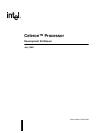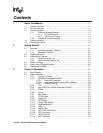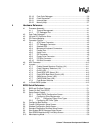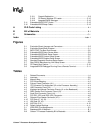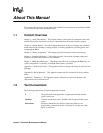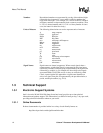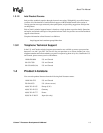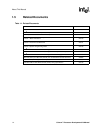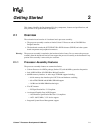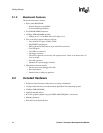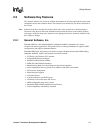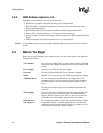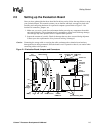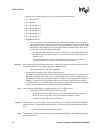
1-2
Celeron™ Processor Development Kit Manual
About This Manual
1.3 Technical Support
1.3.1 Electronic Support Systems
Intel’s site on the World Wide Web (http://www.intel.com/) provides up-to-date technical
information and product support. This information is available 24 hours per day, 7 days per week,
providing technical information whenever you need it.
1.3.1.1 Online Documents
Product documentation is provided online in a variety of web-friendly formats at:
http://developer.intel.com/design/litcentr/index.htm
Numbers Hexadecimal numbers are represented by a string of hexadecimal digits
followed by the character H. A zero prefix is added to numbers that
begin with A through F. (For example, FF is shown as 0FFH.) Decimal
and binary numbers are represented by their customary notations. (That
is, 255 is a decimal number and 1111 1111 is a binary number. In some
cases, the letter B is added for clarity.)
Units of Measure The following abbreviations are used to represent units of measure:
Aamps, amperes
Gbyte gigabytes
Kbyte kilobytes
KΩ kilo-ohms
mA milliamps, milliamperes
Mbyte megabytes
MHz megahertz
ms milliseconds
mW milliwatts
ns nanoseconds
pF picofarads
Wwatts
Vvolts
µA microamps, microamperes
µF microfarads
µs microseconds
µW microwatts
Signal Names Signal names are shown in uppercase. When several signals share a
common name, an individual signal is represented by the signal name
followed by a number, while the group is represented by the signal name
followed by a variable (n). For example, the lower chip-select signals
are named CS0#, CS1#, CS2#, and so on; they are collectively called
CSn#. A pound symbol (#) appended to a signal name identifies an
active-low signal. Port pins are represented by the port abbreviation, a
period, and the pin number (e.g., P1.0).



